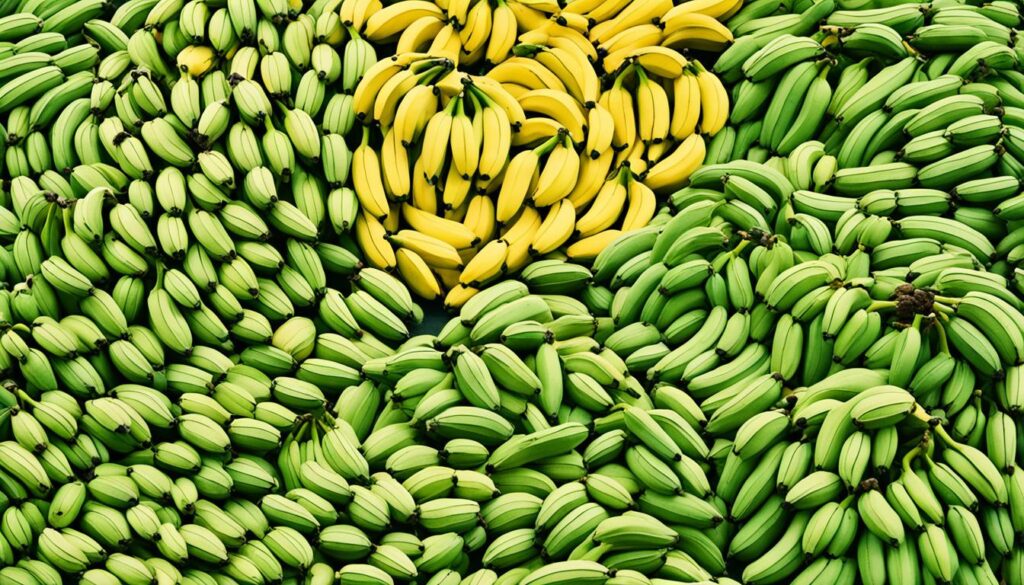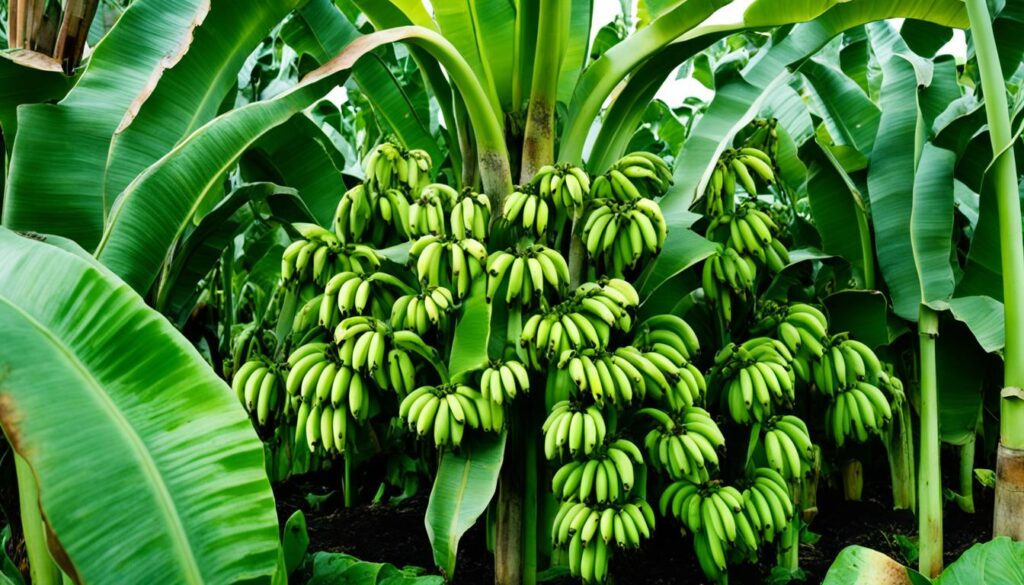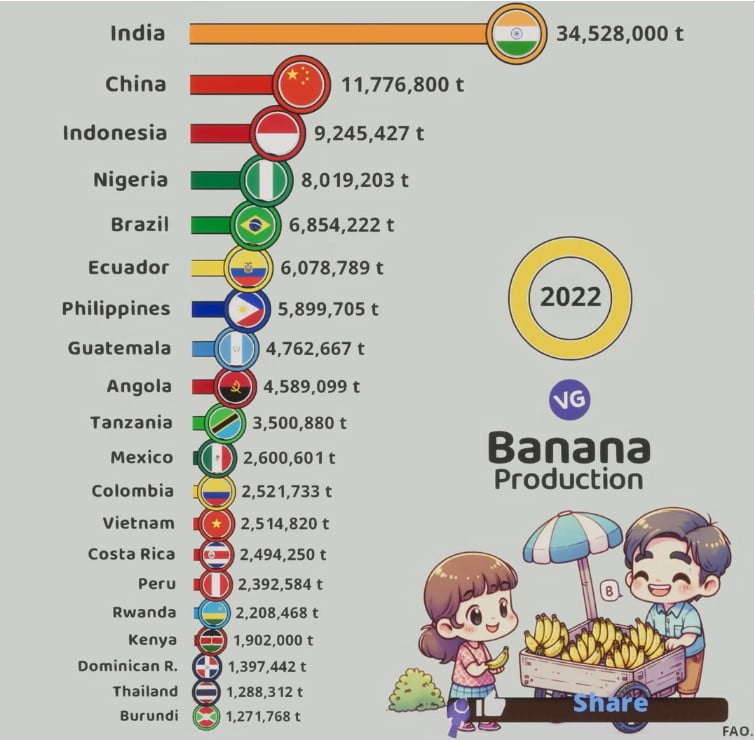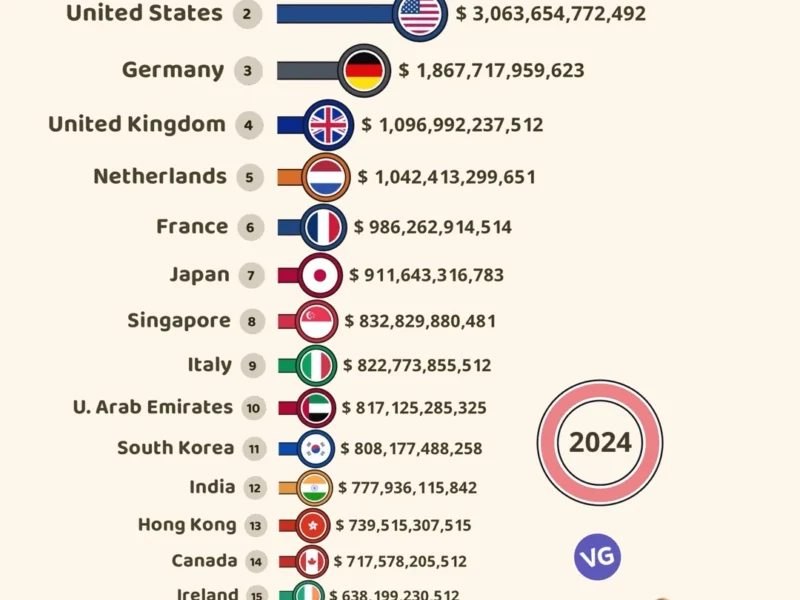Bananas are more than just a favorite breakfast food. They are a big deal worldwide, with 148.4 million tonnes produced in 2016, says the UN Food and Agriculture Organization (FAO)1. This shows how big and important banana production is, making it a top fruit globally.
Biggest Banana Producer in The World
| Country | Flag | Banana Production (tonnes) |
|---|---|---|
| India | 🇮🇳 | 34,528,000 |
| China | 🇨🇳 | 11,776,800 |
| Indonesia | 🇮🇩 | 9,245,427 |
| Nigeria | 🇳🇬 | 8,019,203 |
| Brazil | 🇧🇷 | 6,854,222 |
| Ecuador | 🇪🇨 | 6,078,789 |
| Philippines | 🇵🇭 | 5,899,705 |
| Guatemala | 🇬🇹 | 4,762,667 |
| Angola | 🇦🇴 | 4,589,099 |
| Tanzania | 🇹🇿 | 3,500,880 |
| Mexico | 🇲🇽 | 2,600,601 |
| Colombia | 🇨🇴 | 2,521,733 |
| Vietnam | 🇻🇳 | 2,514,820 |
| Costa Rica | 🇨🇷 | 2,494,250 |
| Peru | 🇵🇪 | 2,392,584 |
| Rwanda | 🇷🇼 | 2,208,468 |
| Kenya | 🇰🇪 | 1,902,000 |
| Dominican Republic | 🇩🇴 | 1,397,442 |
| Thailand | 🇹🇭 | 1,288,312 |
| Burundi | 🇧🇮 | 1,271,768 |
Leading the way in banana production are a few countries. They include India and China with their lush tropical lands, and Ecuador and the Philippines with their equatorial climates. These countries are key in meeting the world’s demand for bananas2.
As the world’s population grows, so does the need for bananas. The role of these top banana producers is vital. They help the world economy by providing jobs and food for millions2.
Key Takeaways
- Bananas are one of the most widely cultivated and consumed fruits globally, with an estimated 148.4 million tonnes produced worldwide in 2016.
- The top banana producing countries include India, China, the Philippines, Ecuador, Indonesia, and Brazil, accounting for a significant portion of the world’s total banana and plantain production.
- Banana production and export play a crucial role in the economies of many developing countries, making it an important cash crop worldwide.
- The global demand for bananas continues to grow, highlighting the importance of these top producing countries in feeding the world’s appetite for this iconic fruit.
- Cultivating and exporting bananas provides a vital source of income and sustenance for millions of people across the globe.
Introduction to Banana Production
The global banana industry is a big deal in the world of farming. About 15% of bananas grown worldwide are sent to other countries for people to eat3. In the United States, bananas are the top fruit choice, beating out apples and oranges in consumption3.
Banana Production in 2022 (tonnes)
Source: Image data, 2022
The Global Banana Industry
Bananas are grown on big farms, mostly in the Americas4. The banana business has a big effect on the environment, using a lot of pesticides and leading to deforestation4. In the late 1990s and early 2000s, the world produced about 92 million tonnes of bananas each year. By 2001, this number went up to 99 million tonnes5. By 2016, bananas and plantains together produced 148 million tonnes3.
Importance of Bananas in the World Economy
The banana trade is worth between US$4.5 and 5 billion every year5. In 2012, the world exported 16.5 million metric tons of bananas, which was 7.3% more than the year before3. Five big fruit companies controlled 44% of the banana trade in 20133. Most of the bananas we eat are Cavendish bananas, even though there are many other types5.
“The global banana industry has been associated with human rights violations, including forced labor in countries like Côte d’Ivoire, Cameroon, Ghana, Guatemala, and Ecuador.”
Top Banana Producing Countries
The global banana industry is led by a few key countries. India is the top banana producer, making 30.5 million tonnes a year6. China is second, producing 12 million tonnes, which means 8.61 kilograms per person6. Indonesia comes third, making 7.3 million tonnes or 27.47 kilograms per person6.
India: The World’s Largest Banana Producer
India leads in banana production, making 30.5 million tonnes a year6. This makes up almost 20% of the world’s bananas7. The country’s good climate and large farms help it stay on top6.
China: A Rising Powerhouse in Banana Production
China is a big player in bananas, producing 12.1 million tonnes a year8. This means each person eats 8.61 kilograms6. China’s efforts in growing bananas and its big population have made it a key player.
| Country | Banana Production (million tonnes) | Per Capita Banana Consumption (kg) |
|---|---|---|
| India | 30.5 | N/A |
| China | 12.1 | 8.61 |
| Indonesia | 7.3 | 27.47 |
| Brazil | 6.8 | 32.51 |
| Ecuador | 6.6 | 385.75 |
The top five countries for banana production, including India, China, the Philippines, Colombia, and Indonesia, make over 55% of the world’s bananas7. This shows how important these countries are in the global banana market7.
“India’s banana production is unparalleled, with an annual output of 30.5 million tonnes, accounting for nearly 20% of the global banana production.”
Major Banana Exporting Nations
The global banana trade is booming, with many countries playing big roles. Ecuador is the top banana exporter, and the Philippines is also a big player.
Ecuador: The Banana Export Leader
Ecuador is the biggest banana exporter in the world9. In 1974, it joined the Union of Banana Exporting Countries (UPEB) to set an export tax9. But the UPEB failed due to a bribery scandal with United Brands Company9.
Now, Ecuador’s banana industry is still a giant, making up 30% of global trade in the 1990s10. It employs about 380,000 people, with most farms being small or medium-sized10. Most of its bananas go to North America and Europe, but it’s also reaching Eastern Europe and Asia10.
Philippines: A Significant Player in the Banana Trade
The Philippines is also a big name in bananas11. In 2023, it was the second-biggest exporter, with sales making up 8.1% of the world’s bananas11. Its banana exports grew by 4.1% each year from 2019 to 2023, reaching $14.4 billion11.
The Philippines’ banana farms are mostly big and owned by companies, playing a big part in the country’s exports11. Big companies like Chiquita, Dole, and Del Monte control most of the global banana market11.
“Ecuador’s banana production outlook is positive, with increasing export capacity, stable area planted, and potential productivity gains compared to neighboring exporting nations.”10
Despite challenges, Ecuador and the Philippines are key players in the banana trade. They add strength and variety to the global market91110.
Banana Producing Countries
The global banana industry is vibrant and crucial, with countries worldwide playing a big part in banana production12. It’s estimated that around 86 million tonnes of bananas are produced each year12. India leads as the biggest producer, adding about 14.2 million tonnes yearly12. It’s expected to stay at the top in 2024, producing 33 million tons12.
Other big players include China, Indonesia, Brazil, Ecuador, the Philippines, Guatemala, Colombia, Thailand, and Uganda12. China produces around 12.1 million tons yearly, and Brazil adds 7.2 million tonnes12. These countries are key to keeping bananas available worldwide12.
In India, bananas are mainly grown in Maharashtra12. China’s main banana areas are in Guangdong, Yunnan, and Hainan12. Indonesia grows bananas on many islands, with big production in Sumatra and Java12. These countries are crucial for the global banana market, meeting both local and international needs12.
| Country | Banana Production (Tonnes) |
|---|---|
| India | 30.5 million12 |
| China | 12.1 million12 |
| Brazil | 7.2 million12 |
| Ecuador | 7.1 million12 |
| Indonesia | 7.0 million12 |
Many countries help supply bananas globally, besides the top producers13. Over 100 billion bananas are eaten every year, showing the huge demand for this fruit13.
Environmental Impact of Banana Cultivation
The banana industry is key to the global economy but has a big environmental impact. It uses intensive farming methods that harm the ecosystems14.
Deforestation and Habitat Loss
Clear-cutting rainforests for bananas leads to deforestation and habitat loss14. This hurts biodiversity by pushing out many species and upsetting nature’s balance.
Pesticide Use and Soil Degradation
Bananas need a lot of pesticides, about 35 pounds per acre14. This can make the soil worse, pollute water, and harm animals and people.
The long journey bananas take and their packaging also harm the environment14.
To fix these issues, bananas should be grown in a more eco-friendly way. This means using fewer pesticides, organic farming, and protecting nature14.
“The banana cultivation process involves clear-cutting tracts of primary rainforest, contributing to environmental destruction.”
The banana industry is important but its harm to the environment is clear. By being more eco-friendly, it can lessen its impact and keep banana farming going14.
| Environmental Impact | Implications |
|---|---|
| Deforestation and habitat loss | Displacement of species, disruption of ecological balance |
| Pesticide use and soil degradation | Contamination of water sources, poisoning of wildlife and communities |
| Carbon footprint from food miles and packaging | Contribution to climate change |
As bananas become more popular, the industry must tackle these issues. It needs to be more eco-friendly to keep banana farming going1415.
Socioeconomic Aspects of the Banana Industry
The global banana industry has faced many labor issues and human rights concerns16. Some workers have sued companies due to health problems from pesticides. Others are also in legal battles16. Workers use masks, boots, gloves, and special clothes to stay safe, but these can be hard to wear in the heat and humidity16.
Labor Practices and Human Rights Concerns
Workers in the banana trade have faced exploitation and ignored rights16. Issues include child labor, long hours, and not being treated fairly16. There are often disagreements between workers and companies16. Chiquita made an agreement with worker unions in 2001, but problems still exist16.
The socioeconomic impact of the banana industry goes beyond just labor17. In Ethiopia, banana exports started small in 1961 but grew a lot by 197217. Most bananas in Ethiopia are dessert bananas, mainly from the Southern Nations and Nationalities Peoples’ Regional State17. The Gamo Gofa, Bench Maji, and Sheka zones are top banana producers17. Arba Minch Zuriya district in Gamo Gofa zone dedicates 11,000 hectares to bananas17.
| Key Socioeconomic Impacts | Details |
|---|---|
| Forced Labor and Human Rights Violations | The banana industry has been plagued by instances of slavery, forced child labor, and other labor abuses in producing countries16. |
| Environmental Degradation | Banana cultivation often involves deforestation, habitat loss, and excessive pesticide use, leading to soil degradation16. |
| Worker Health and Safety Concerns | Handling of hazardous pesticides and lack of proper safety equipment put banana workers at risk of health issues16. |
| Economic Dependence and Volatility | Many developing countries rely heavily on banana exports, making them vulnerable to market fluctuations17. |
The banana industry faces many socioeconomic challenges, from labor rights to environmental issues. Fixing these problems is key for a fair and sustainable banana trade18.

“The relationship between worker unions and banana companies is often contentious, but some progress has been made in improving labor relations, though tensions remain.”
Major Banana Companies and Market Shares
In 2013, a few big companies controlled most of the banana trade worldwide. Chiquita had 13%, Fyffes 6%, Dole Food Company 11%, Fresh Del Monte 12%, and Noboa 2%19.
Now, these big companies are less in charge. They’ve sold their farms and buy more from small producers19. Big supermarkets in the US and EU now have more power over banana production19.
Chiquita, Dole, and Del Monte: The Banana Giants
Chiquita, Dole, and Del Monte are the big names in bananas. They lead the global banana trade with their big resources and wide reach1920.
Chiquita is famous for its blue sticker20. Dole sells more than just bananas, offering many fruits and veggies20. Del Monte is a leader in canned fruits and veggies and also big in bananas20.
These companies still lead the banana market but things are changing. Retail chains and focus on sustainable practices are becoming more important1920.
Threats to Banana Production
The banana industry is facing big challenges, especially from diseases. A major worry is Tropical Race 4 (TR4), a dangerous fungus. This disease could destroy banana plantations and threaten the Cavendish banana, which is a big part of our bananas1421.
TR4 spreads easily through dirty soil and tools used by big farms14. It can wipe out Cavendish bananas completely21. Since Cavendish bananas make up 47% of all bananas, TR4 is a big threat21.
Other problems include deforestation, losing habitats, and using too many chemicals14. These issues harm the environment and disrupt ecosystems.
There are also big issues with how workers are treated. There’s child labor, violence against unions, and low wages14. This makes the industry look bad and hurts the people who work there.
Every year, we eat about 100 billion bananas22. These problems could affect our food supply and the jobs of many people. We need to work on sustainable farming, fair work conditions, and disease-resistant bananas to keep bananas safe142122.

Plant Diseases and the Spread of Tropical Race 4
The spread of Tropical Race 4 (TR4) is a big threat to bananas. This fungus can destroy banana farms and threaten the Cavendish banana, which is a key type1421.
TR4 spreads fast through dirty plants, water, and soil21. It could kill off Cavendish bananas, which are a big part of our bananas21. Big farms spread it by using dirty tools14.
| Threat to Banana Production | Impact |
|---|---|
| Tropical Race 4 (TR4) Disease |
|
| Environmental Impact | |
| Labor Practices and Human Rights Concerns |
The banana industry faces big challenges, from deadly diseases like TR4 to environmental and social issues142122. We need to work on making bananas more resistant to disease, farming in a sustainable way, and treating workers fairly. This will help keep bananas safe for everyone142122.
Sustainable Banana Farming Practices
There’s a big push for sustainable banana farming to tackle environmental and social issues. This means using organic banana cultivation methods, cutting down on pesticides, and better managing waste and water23.
Some banana companies and cooperatives are working to improve working conditions and fairness in their supply chains. But, making the switch to environmentally-friendly banana production is a big challenge24.
- Rainforest Alliance Certified banana farms in Latin America are changing old ways thanks to the organization’s efforts23.
- Still, many banana farms focus more on making lots of bananas than on taking care of workers and the planet to meet demand23.
- On Rainforest Alliance Certified farms, banana plants last longer, up to 30 years, which means more bananas over time23.
- These farms use groundcover to stop soil erosion and keep moisture in the soil, which cuts down on herbicides and saves money23.
- With climate change, using smart farming methods like those on certified farms is key in tropical areas23.
- Workers on these farms make sure bananas are the right size and use compost to help the soil, all part of being certified23.
- These farms also have a system to clean water so it’s safe to use again in the fields23.
- And, they recycle blue plastic bags into packaging straps, making their whole banana supply chain more eco-friendly23.
| Country | GlobalG.A.P.-Certified Banana Area (hectares) |
|---|---|
| Ecuador | 71,80025 |
| Colombia | 42,50025 |
| Guatemala | 29,00025 |
| Costa Rica | 26,60025 |
| Dominican Republic | 14,60025 |
The top five countries grow about 70% of all certified bananas25. Most of these certified bananas come from the Americas, with smaller amounts from Asia, Africa, and other places25.
“Sustainable agriculture can build livelihood assets in the context of smallholder farming.”24
Conclusion
Bananas are a key crop in the world, with countries like India, China, and the Philippines leading in production15. But, the banana trade faces big problems like deforestation, pesticide use, and poor working conditions26. Efforts to make things better are happening, but the future of bananas is still unsure due to diseases27.
Since bananas are eaten by so many people, we need to keep them safe and produced right. Looking at the banana industry’s future shows how important it is to solve these big issues152627.
The banana industry has many challenges, like harming the environment and treating workers unfairly. But, by focusing on being sustainable, treating workers right, and finding new ways to do things, we can make a better future for everyone152627.
FAQ
What are the top banana producing countries in the world?
The top banana producers are India, China, the Philippines, Ecuador, Indonesia, and Brazil. Together, they produce over 70% of the world’s bananas and plantains.
How much is the total global banana production?
In 2016, the UN Food and Agriculture Organization (FAO) reported that the world produced 148.4 million tonnes of bananas and plantains.
What role does banana production and export play in the economies of developing countries?
For many developing countries, bananas are a key export. They bring in much-needed cash and support local economies.
What percentage of global banana production is exported and traded internationally?
About 15% of bananas are sent out of their countries for people to eat in Western countries.
Which country is the largest exporter of bananas in the world?
In 2013, Ecuador led the world in banana exports, sending out 5.4 million tonnes.
What are the environmental concerns associated with banana cultivation?
Bananas need a lot of pesticides, which harms the soil and nature. They also cause deforestation and harm natural habitats, leading to fewer species.
What are the labor and human rights issues in the banana industry?
The banana industry has faced many human rights problems. This includes slavery, child labor, and other labor issues in banana-growing countries.
What is the market dominance of the major banana companies?
In 2013, five big fruit companies controlled 44% of the banana trade. But, they’ve been losing ground as they buy more from independent farmers.
What is the threat of plant diseases to global banana production?
Diseases like Tropical Race 4 (TR4 are a big threat to bananas. They can destroy plantations and threaten the Cavendish banana, which is the main type grown for export.
What are the efforts towards sustainable banana farming practices?
People are moving towards better banana farming. This includes using fewer pesticides, managing waste better, and saving water. Some companies are also working on improving working conditions and making the supply chain fairer.
Source Links
- Present Situation of World Banana Production and Trade and I – https://ideas.repec.org/a/ags/asagre/338344.html
- Bananas | FAO | 联合国粮食及 农业组织 – https://www.fao.org/markets-and-trade/commodities/bananas/zh/
- Banana industry – https://en.wikipedia.org/wiki/Banana_industry
- FE901/FE901: Banana Market – https://edis.ifas.ufl.edu/publication/FE901
- The World Banana Economy, 1985-2002 – https://www.fao.org/4/y5102e/y5102e04.htm
- Banana Production by Country 2024 – https://worldpopulationreview.com/country-rankings/banana-production-by-country
- Banana-producing countries portal | Improving the understanding of banana – https://www.promusa.org/Banana-producing countries portal
- Top 10 Banana-Producing Countries in the World – https://www.geeksforgeeks.org/banana-producing-countries-in-the-world/
- Union of Banana Exporting Countries – https://en.wikipedia.org/wiki/Union_of_Banana_Exporting_Countries
- The World Banana Economy, 1985-2002 – https://www.fao.org/3/y5102e/y5102e05.htm
- Bananas Exports by Country 2023 – https://www.worldstopexports.com/bananas-exports-country/
- Top-10 Banana Producing Countries in the World 2024 – https://currentaffairs.adda247.com/top-10-banana-producing-countries-in-the-world/
- Peeling Back the Truth on Bananas – Food Empowerment Project – https://www.foodispower.org/our-food-choices/bananas/
- Peeling Back the Truth on Bananas – Food Empowerment Project – https://foodispower.org/our-food-choices/bananas/
- The Environmental Profile of Ecuadorian Export Banana: A Life Cycle Assessment – https://www.ncbi.nlm.nih.gov/pmc/articles/PMC9601378/
- The World Banana Economy, 1985-2002 – https://www.fao.org/4/y5102e/y5102e08.htm
- Banana as a Cash Crop and Its Food Security and Socioeconomic Contribution The Case of Southern Ethiopia, Arba Minch – https://www.scirp.org/journal/paperinformation?paperid=74908
- EST: Banana facts – https://www.fao.org/economic/est/est-commodities/oilcrops/bananas/bananafacts/en/
- Bananas | FAO | Food and Agriculture Organization of the United Nations – https://www.fao.org/markets-and-trade/commodities/bananas/en/
- Banana Market Size: Growth Insights and Future Strategies by 2032 – https://www.linkedin.com/pulse/banana-market-size-growth-insights-future-strategies-c4hnf
- Deadly disease threatens banana production in Latin America – https://foodtank.com/news/2021/09/latin-american-banana-production-faces-threats-from-disease/
- Battle for the banana: Disease and climate change threaten world’s favourite fruit – https://www.thenationalnews.com/weekend/2023/07/28/battle-for-the-banana-disease-and-climate-change-threaten-worlds-favourite-fruit/
- How Are More Sustainable Bananas Grown? – https://www.rainforest-alliance.org/insights/how-are-more-sustainable-bananas-grown/
- Adoption of Sustainable Agriculture Practices in Banana Farm Production: A Study from the Sindh Region of Pakistan – https://www.ncbi.nlm.nih.gov/pmc/articles/PMC7277408/
- Good agricultural practices for bananas | World Banana Forum | Food and Agriculture Organization of the United Nations – https://www.fao.org/world-banana-forum/projects/good-practices/good-agricultural-practices/en/
- Find out a bunch of facts about Fairtrade bananas – https://www.fairtrade.org.uk/farmers-and-workers/bananas/about-bananas/
- BANANA – https://nhb.gov.in/report_files/banana/BANANA.htm



